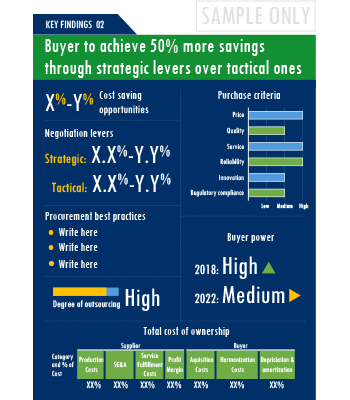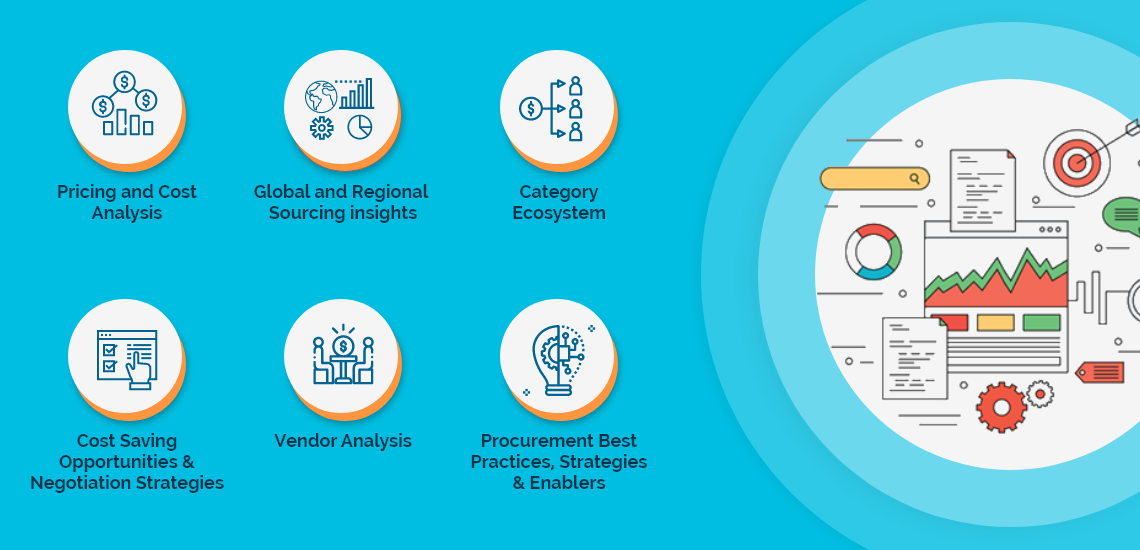A purchasing guide for Lubricating Oils – rich advisory on spend outlook in Lubricating Oils, pricing analysis for Lubricating Oils procurement cost benchmarking, negotiation strategies and key vendors of Lubricating Oils.
GET FREE SAMPLEEcosystem of the global Lubricating Oils category is intertwined with the larger parent market of Non-Medical Chemicals Minerals and Gases. Our category definition describes that overall Non-Medical Chemicals Minerals and Gases market includes all spend on procurement, transportation, conservation and storage of industrial chemicals, minerals and gases. Spend on similar products for medical and pharmaceutical usage is excluded from this category.
Non-Medical Chemicals Minerals and Gases market around the world is undergoing rapid transitions that have a massive potential to influence the way companies strategize for Lubricating Oils procurement and the cost they have to incur. Suppliers of Lubricating Oils are moving up the value chain - both organically as well as through M&As. Their portfolios are increasingly being diversified with the objective of offering integrated solutions that go beyond just Lubricating Oils. Even buyers are engaging vendors who can act as a one-stop solution provider across their geographic footprint. Such strategic engagements can help buyers with savings associated with economies of scale and management of a much smaller supplier base. Customers are expecting service and experience levels which are at par with what ecommerce and consumer sectors of today offer. Moreover, competition keeps intensifying and demand and supply dynamics keep shifting. Suppliers are under an enhanced pressure to offer greater quality, options that suit unique requirements and overall experience of the customer stakeholders involved.
It has become imperative for category managers to remain as agile as possible in terms of their procurement practices. However, it is not always easy to quickly spot and implement alternative practices in a category like Lubricating Oils. To help quick decision making, this report advises on several procurement best practices that have worked well for category managers. For example, Competitive bidding as a cost optimization tool is extremely potent but should be carefully deployed only when there is no significant differentiation among Lubricating Oils suppliers.Buyers must have a clear understanding of the subcontracting policies, if any, of Lubricating Oils suppliers. Factors such as cost incurred, service quality, adherence to timelines, and regulatory compliance of subcontractors employed by suppliers should be carefully assessed prior to engagement.Buyers should assess the level of adoption of the latest technologies by suppliers to assess cost-saving opportunities and quality that can be provided by the latter. For instance, the adoption of technologies such as cloud computing will enable suppliers to reduce their internal computing hardware requirements for operations such as CAD and CAM. This can, in turn, enable them to reduce their operating costs, thereby suppliers can offer products at lower rates to buyers.
Activate your free account to gain easy access to cutting edge research and insights on consumers, emerging price trends, global and regional suppliers.
Lubricating Oils procurement managers also need to proactively identify and mitigate potential risks that can arise in the supply chain or contracts for Lubricating Oils procurement. Some examples include:
For detailed insights and complete access to our report library, activate your free account!
Procurement decisions can prove to be costly in the absence of careful deliberation and evaluation of every available option. In fact, more than 90% of the decision makers we work with acknowledge that timely availability of up-to-date category intelligence can help them make better purchasing decisions. More than 80% of them believe that in-house category intelligence needs to be updated periodically to achieve full benefits. If you have read so far, we are quite sure you agree!!
You may have just initiated your research to design a winning Lubricating Oils procurement strategy, or you may be a category expert looking for strategic insights and updated data.Either ways, the report has your requirements covered.
The report is intended to serve as a one-stop reference guide for Lubricating Oils procurement strategy and offers a perfect blend of category basics with deep-dive category data and insights. Therefore, it is ideal for category beginners looking for “Lubricating Oils: Procurement Report 101” as well as for category experts actively tracking the global Lubricating Oils procurement market.

Unlock SpendEdge's comprehensive procurement report collection with ease through our procurement platform.
The Lubricating Oils procurement report helps take more informed decisions by placing all the critical information and advice at the fingertips of a decision maker. It also specifically answers some of the key questions that we have been routinely asked during our industry outreach initiatives:
SpendEdge Insights has helped procurement professionals and sourcing teams manage multiple spend areas and achieve more than $2 billion in savings. Activate your free account today!
The Lubricating Oils market report offers a complete picture of the supply market and analyzes the category from the perspective of both buyers and suppliers. Analysis of the category trends, procurement best practices, negotiation levers and overall category management strategy advisory are interspersed with in-depth data and commentary on spend outlook, pricing ecosystem and supplier landscape drilled down to a region-level coverage.

A key highlight of this report is the in-depth outlook created on Lubricating Oils procurement spend and pricing trends. The report further delves deep into the aspects of cost structure, total cost of ownership and supplier margins for Lubricating Oils. A dedicated section to supplier profiles and evaluation helps decision makers cast a wider procurement net and identify gaps in existing relationships.

Along with specific category and supplier intelligence, the publication also includes curated insights on Lubricating Oils market trends, price influencers and inherent risks. These insights help the decision makers prepare for market shaping trends in advance and create alternative strategies for changes in the market conditions.

Additionally, the report also advises on the best practices and strategies to manage the Lubricating Oils category efficiently. Negotiation levers and opportunities are explained in detail along with quantification of their potential. Benchmark KPIs for supplier and buyer performance management are also aggregated to better organize the category objectives. Other themes of advisory include ideal procurement organization structure, enablers to achieve KPIs or category objectives and ideal SLAs to have with suppliers.






Our research is complex, but our reports are easy to digest. Quantitative analysis and exhaustive commentary is placed in an easy to read format that gives you an in-depth knowledge on the category without spending hours to figure out “what does it mean for my company?”


SpendEdge presents a detailed picture of Lubricating Oils procurement solutions by way of study, synthesis, and summation of data from multiple sources. The analysts have presented the various facets of the market with a particular focus on identifying the key category influencers. The data thus presented is comprehensive, reliable, and the result of extensive research, both primary and secondary.

Global Particleboard Market - Procurement Intelligence Report

Global Noble and Elemental Gases Market - Procurement Intelligence Report

Global Lubricant Spray Market - Procurement Intelligence Report

Global Paraffins Market - Procurement Intelligence Report

Global Engine and Transmission Oil Market - Procurement Intelligence Report

Global Transformer Oil Market - Procurement Intelligence Report

Global Greases Market - Procurement Intelligence Report

Global Unfinished Plywood Market - Procurement Intelligence Report

Global Igniters Market - Procurement Intelligence Report
Access this report and our entire procurement platform | Plans starting from USD 3000/ Year Buy Now
Copyright © 2024 Infiniti Research Limited. All Rights Reserved. Privacy Notice – Terms of Use – Sales and Subscription
Cookie Policy
The Site uses cookies to record users' preferences in relation to the functionality of accessibility. We, our Affiliates, and our Vendors may store and access cookies on a device, and process personal data including unique identifiers sent by a device, to personalise content, tailor, and report on advertising and to analyse our traffic. By clicking “I’m fine with this”, you are allowing the use of these cookies. You may change your settings based on a legitimate interest at any time, by selecting “Manage Settings” on our site. Please refer to the help guide of your browser for further information on cookies, including how to disable them. Review our Privacy & Cookie Notice.
